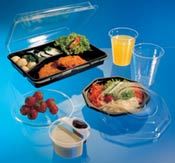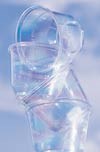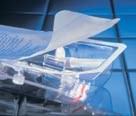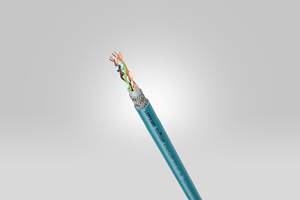SBCs Are Back With More Capacity & New Grades
Two years ago, a supply crisis struck the SBC market. Some customers were forced to switch to other materials. Today, SBC producers hope to lure back processors with a surge of new resin capacity, new domestic suppliers, and new grades and applications.
Styrene-butadiene block copolymers with high (70% to 85%) styrene levels are once again a viable option for processors who serve markets for clear packaging and medical and consumer products. High-styrene SBCs never lost the attraction of sparkling clarity, exceptional gloss, outstanding toughness, and easy processing. They also blend easily with other materials and their density of 1.01 g/cc is 20% to 30% lower than competing high-clarity materials like PET and polycarbonate. The problem for the past two years was a severe global capacity pinch that restricted SBCs’ availability. That “dry” period is now ending, and processors can take advantage of a wider variety of SBC suppliers, products, and applications than ever before.
In the 1990s, SBCs boomed as marketers seized on clarity as a symbol of product purity and as a handy way to allow consumers to peer into products like appliances to check them for function and quality. SBCs retained their appeal even when newer high-clarity materials—metallocene PE and PP and clarified PP—mounted a competitive challenge. SBCs typically cost around 85¢/lb for general-purpose grades to $1.10/lb for specialty (e.g., medical) types.
Two years ago, Chemical Market Resources, a Houston-based consulting firm, pegged North American usage at 310 million lb/yr and underlying growth at 5%/yr. That market scenario was torn apart in March 2000 when an explosion and fire knocked out the 300-million-lb K-Resin SBC plant operated by Chevron Phillips in Pasadena, Texas. In one instant, 100% of U.S. and 50% of global SBC capacity was out of commission. Chevron Phillips scrambled to supply customers from a plant in Asia and existing inventory.
Today, the SBC industry is poised for a strong comeback. Chevron Phillips has restored two-thirds of its previous capacity (with more to come), while other suppliers have stepped in with expansions of their own (see Table 1). Today’s SBC supply base is modernized, more diverse, and more global in reach than it was two years ago.
Equally important, throughout the SBC drought, development of new applications and resin grades continued unabated at Chevron Phillips and its competitors. Now that supply is back, the R&D work is paying off. Notable examples are new breathable films for modified-atmosphere packaging and new blends with higher-performance styrenics aimed at replacing costlier materials in durable goods and consumer products.
Coping with crisis
Industry sources credit Chevron Phillips for responding effectively to the supply crunch. The company kept K-Resin prices steady and supplied customers as best it could by drawing on a 115-million-lb joint-venture facility in Korea. Today, the company has restored 200 million lb of capacity to service. Nevertheless, there have been inevitable resin shortfalls. Some end-users responded by shifting to other high-clarity materials or modifying blend ratios to minimize SBC use. Some delayed conversions to SBC to await a more stable supply situation.
David Morgan, general manager of the K-Resin business, says Chevron Phillips will recommission an additional 135 million lb of K-Resin capacity shortly. It will be placed on standby for start-up sometime in 2003 or ’04.
Morgan adds that there has been no let-up in efforts to take SBC performance “to the next level” and develop new applications. The company’s commercial slate includes grades tailored for film (KR10), sheet (KR03 and KR05), blow molding (KR05), and injection molding (KR01 and KR03). New grades have been added, including NW (no-wax) versions for sheet that are claimed to be more amenable to high-quality printing. In blow molding, Chevron Phillips now offers the developmental CK02 grade for making softer, tougher squeezable bottles.
Meanwhile, competing suppliers saw the supply crisis as an opportunity to increase their capacity and improve market share. BASF expanded its plants in Germany and Belgium and has a 65-million-lb European addition due for startup by mid-year. It is also building a 100-million-lb facility in Mexico to be on-line in 2003 for serving its fast-expanding North American customer base.
AtoFina, whose SBC capacity is concentrated in France, had previously focused on European markets. But in late 2001 the company doubled its dedicated capacity for making FinaClear SBC to 88 million lb. Nicholas Lecouvet, product manager, says AtoFina is now better positioned to serve North America. The supplier has established warehouses in the U.S. and claims it is better able to meet just-in-time delivery requirements.
A new global player has also emerged. In mid-2000, Kraton Polymers was spun off as an independent entity by Shell Chemical. In mid-2001, Kraton Polymers launched the Kraton D series, its first foray into SBCs. Up to then the Kraton business had long been the leading global supplier of SBS and SEBS thermoplastic elastomers—a quite different class of styrene-butadiene block copolymers. The elastomers have lower (10% to 40%) styrene levels, do not impart high clarity and gloss, and are mostly used as impact modifiers. However, they use similar feedstocks, and the same production units can make different block copolymers. In recent months, Kraton Polymers has doubled its SBC capacity in the U.S., though the company declines to specify the amount.
The company’s initial product slate includes Kraton D-1401P, a 75%-styrene, high-clarity, low-gel resin for uses ranging from extruded film and sheet to injection molding. An early commercial use is in blends for making airline drink cups, where consistent production on existing equipment is said to be an advantage. Kraton D-1155 is a 40%-styrene grade described as a softer (but still clear) option for boosting toughness in PS blends.
In short, the SBC supply base today is far stronger than it was two years ago. As of mid-2000, global SBC capacity stood at 260 million lb/yr, or enough to satisfy perhaps 50% of global market demand. Today, that figure has jumped by around 130% to a total of 600 million lb/yr. Plans are in place to add another 295 million lb, or 50% more, to global capacity over the next two years.
Changes in the supply base go beyond mere numbers. Before the crisis, there was a single supplier based in the U.S. Now, four companies are positioned to deliver products in the region. Moreover, industry consultants agree that today’s global capacity for SBCs is based on more modern, efficient, and safe production plants.
More with less
Dr. Ulrike Breiner, BASF’s Styrolux market manager, notes that there are numerous parameters—block structures, morphologies, and monomer ratios—that can be manipulated to change SBC properties and processing characteristics. She says that makes it feasible for the suppliers to differentiate and fine-tune their products in various ways. BASF’s current slate includes an extrusion resin (Styrolux 684D) and an injection molding grade (656C), and the company is preparing to introduce new-generation products.
Suppliers are fine-tuning SBC products to trim cost or tailor them for specific applications or equipment. Their strongest push is toward “extensible” SBC grades that can be “stretched” farther in blends to save money. The goal is to improve the rubber efficiency in SBCs so as to increase toughness without sacrificing clarity, stiffness, or other key properties. That makes it feasible to reduce the ratio of SBC to PS in blends from the current 60:40 ratio to 40:60. The cost of SBC is about double that of crystal PS, so any reduction in the SBC fraction is economically attractive.
Chevron Phillips initiated the trend to extensible SBCs four years back by introducing a developmental grade, XK40, aimed at extrusion. The company now has in development a version of XK40 intended to extend K-Resin’s efficiency in blending.
Steven Shelby, K-Resin sales and marketing manager, remarks that end users stand to gain from extensible SBCs by tapping their potential for “down-blending” or downgauging in blends with PS. He says the payoff can either be a lower ratio of SBC (down-blending) or by using the improved grade at the same ratio to increase toughness, thereby offering potential for downgauging the final product.
BASF recently introduced Styrolux 3G 55, a product identified as a “third-generation” extensible SBC for extruded film and sheet. It has 300% ultimate elongation—around 50% higher than for BASF’s existing grade. That translates into potential for about 25% in down-blending capability without sacrificing other properties, claims BASF’s Breiner. A notable improvement in stress-crack resistance is also claimed.
BASF’s customers in Europe are taking the windfall by down-blending, downgauging, or—in the case of dairy containers—by getting a higher margin of safety in stress-crack performance. BASF is developing a third-generation extensible grade for injection molding.
AtoFina’s Lecouvet says his company is developing a new-generation grade aimed at down-blending and downgauging in extrusion. FinaClear 949 is said to enhance down-blending capability to a degree that rivals other extensible products now entering the market. AtoFina expects to launch some offerings specifically for injection molding in a few months.
AtoFina also offers Optiblend, a combination of crystal PS, high-styrene SBC, and low-styrene SBC that reportedly enhances low-temperature impact strength and downgauging potential in sheet. The tradeoff is a modest loss in clarity.
For films, Chevron Phillips has two developmental grades, DK 11 and DK 13, offering low gel content and improved heat stability. They are higher-stiffness and high-toughness products, respectively, tailored for blending and coextrusion. They offer potential in shrink films since they draw on SBC’s high but balanced shrink force. A shift to SBC shrink labels and sleeves has already occurred in Europe and Japan, and is expected to emerge in the U.S.
Applications expand
SBCs are firmly entrenched in blends (mostly with PS) and as a stand-alone option in thermoforming (60% of SBC consumption), injection molding (20%), films (8%) and blow molding (7%), according to a CMR study. The firm says applications range from thermoformed drink cups, yogurt containers, and trays to food and pharmaceutical bottles, films for food and medical packaging, and molded coat hangers, toys, housewares, medical equipment, and appliance parts (e.g., dust covers).
A growing application for SBCs is modified-atmosphere packaging (MAP), particularly breathable films used in multi-layer form-fill-seal packages for fresh salads, vegetables, and fruit. “SBC films have favorable breathability attributes,” states Roland Planeta, an applications engineer at Tyco Plastics in Sparks, Nev. Tyco (formerly Barrier Films) specializes in five- and seven-layer coextruded food packaging. Planeta says SBC, OPP, and PE films have advantages over materials like PET and nylon 6 in terms of higher transmission rates for oxygen, CO2, and moisture (Table 2).
OPP and PE films currently dominate the breathable films market mainly because they provide superior “yield” vs. SBC, a function of lower cost per pound and lower density. But Planeta says SBC films can provide advantages in some sectors. For instance, in the high-breathability sector (e.g., strawberries and certain fruits), SBC films offer significantly higher oxygen and CO2 transmission rates than OPP and PE.
SBC (unlike OPP) is easily coextruded into five- and seven-layer films that can be printed and reportedly provide superior quality vs. laminated OPP. Also, super-thin (0.4-mil) OPP laminated films can be replaced by coextruded SBC when OPP fails to meet oxygen permeation requirements or is excessively flimsy at thin gauges.
Versus PE films, SBC offers better clarity and gloss and higher stiffness (better “stand-up” and crinkle) properties. Advances in SBC coextrusion—notably improved tie-layer materials and better techniques for preventing curl (i.e., film imbalance)—are also enhancing SBC’s suitability for coextrusion, Planeta notes.
A second promising arena is blending of SBC with higher-performing styrenics to “down-engineer” applications currently in higher-cost PC, acrylic, or clear ABS. Possible end-uses include molded appliance parts and medical devices and extruded graphic display profiles.
Prime candidates for blending with SBC in this manner are styrene-methyl methacrylate (SMMA) copolymers supplied by Nova Chemicals. These are Nova Acrylic Styrenic (NAS) alloy and rubber-modified Zylar materials.
“Our styrenics complement SBC well in blending,” declares Greg Wilkinson, Nova’s business director for High-Performance Styrenics. Nova is working with three SBC suppliers on blending SBCs with modest levels (under 10%) of Nova’s styrenics to expand properties without impairing clarity or cost-effectiveness.
Wilkinson cites the use of NAS 90 in blends with SBC to boost stiffness or surface hardness. Tensile modulus of NAS 90 is 490,000 psi, about double that of SBC. In a 50:50 blend, that translates into 30% higher stiffness with modest loss of clarity and toughness. In applications needing a boost in impact strength, rubber-modified Zylar is a candidate, but the tradeoff is lower clarity. NAS costs a little less than SBC, while Zylar grades cost a bit more.
| Table I — Capacity for High-Styrene SBC Resins | ||
| World Capacity, million lb | Planned Additions 2002-2004 | |
| Asahi AtoFina BASF Chevron Phillips Kraton Polymers TOTAL | 65 90a 120 315c NAd 590 | — — 165b 130c — 295 |
| aSBC-dedicated share of a 220-million-lb plant. bIncludes 100-million-lb unit to come on stream n Altamira, Mexico, next year. cIncludes 115-million-lb unit in South Korea. dSBC breakout not disclosed. Company's global elastomer capacity is 660 million lb. | ||
Related Content
Fast-Cycling Selective Laser Sintering System
Nexa3D announced the QLS 260 for metal and polymer production.
Read MoreAdvanced Plastomers for Production of PE-Based Sealant Resins
Nova Chemicals’ new Astute products are suitable for a broad range of applications including food packaging, heavy-duty sacks and e-commerce.
Read MoreTracing the History of Polymeric Materials -- Part 30: Polyurethane
In the world of polymers, polyurethane chemistry is probably the most versatile. This a resulted in a wide range of products made from these materials and given the industry the flexibility to respond to the progressive march of regulatory concerns.
Read MoreBiobased TPU for Broad Range of Applications
BASF’s Elastollan N contains 50% renewable raw material.
Read MoreRead Next
People 4.0 – How to Get Buy-In from Your Staff for Industry 4.0 Systems
Implementing a production monitoring system as the foundation of a ‘smart factory’ is about integrating people with new technology as much as it is about integrating machines and computers. Here are tips from a company that has gone through the process.
Read MoreAdvanced Recycling: Beyond Pyrolysis
Consumer-product brand owners increasingly see advanced chemical recycling as a necessary complement to mechanical recycling if they are to meet ambitious goals for a circular economy in the next decade. Dozens of technology providers are developing new technologies to overcome the limitations of existing pyrolysis methods and to commercialize various alternative approaches to chemical recycling of plastics.
Read More















.png;maxWidth=300;quality=90)















